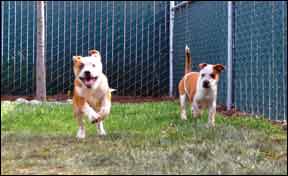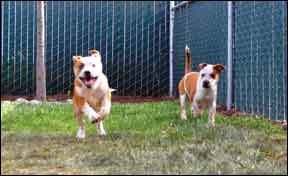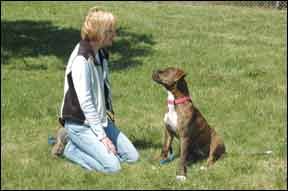The intent of puppy socialization is to convince the part of the puppy’s brain that reacts emotionally to his world (the amygdala) that, in general, the best/most appropriate emotional responses are calm, relaxed, and happy. These days, the importance of puppy socialization is well-known and widely accepted. Interesting, then, that some behavior professionals (myself included) report seeing an increasing number of canine clients with fear-related behaviors.

288
There are several reasons for the apparent increase in fear-related behaviors in dogs, including:
–Less “natural socialization,” as responsible owners keep their puppies safely at home, rather than allowing them to roam the neighborhood.
–The availability of more behavior professionals who are willing and able to work with dogs who display fear-related behaviors, and the awareness of more dog owners that behaviors can be modified.
–A lack of understanding among dog owners who recognize that socialization is important, but don’t realize that key to good socialization is positive exposures to the world. A pup who has negative experiences during the primary (3 to 14 weeks) socialization period is very likely to grow up fearful, unless prompt remedial action is taken.
–A lack of awareness of the existence of secondary fear periods which, according to various information sources, can occur for a dog anywhere between the age of 4 to 11 months, or perhaps as late as 2 years of age. A fear-causing event any time during this period, when a dog is more sensitive to aversive stimuli, can also have far-reaching fear behavior implications.
–The emergence of puppy mills over the last 30 years. Puppy milling only began to boom in the late 1970s and later. Puppy mill puppies do not receive adequate socialization – if any. They are also likely to be shipped to retail outlets during the very significant early fear period (8 to 10, maybe 12, weeks)
–The emergence of the so-called “no-kill” movement, which promotes the placement of behaviorally questionable dogs who, in the past, would more likely have been euthanized.
–A growing number of hoarder case investigations by animal protection agencies that result in the seizure of hundreds of undersocialized/fearful dogs who are then rehomed.
Genetics v. Environment
An often-asked question is, “Is my dog’s fearful behavior genetic, or did someone or something cause it?” The answer is always “both.” Genetics as well as life experiences always have a combined influence on behavior.
In the case of genetics, what is actually heritable is a dog’s propensity to be reinforced by (or to find aversive) a particular behavior. Border Collies are genetically programmed to find running after things to be very reinforcing – so they are good at herding; while Labradors Retrievers have a propensity to be reinforced by putting things in their mouths – hence they are good at retrieving. Conversely, a dog who has a genetic propensity to find new and/or unusual stimuli aversive might be said to be genetically fearful – a common problem for dogs produced by breeders (including puppy mills) who don’t deliberately make an effort to breed for sound temperament.
If you take two puppies of similar age and expose them to a novel stimulus, given equal amounts of proper socialization, the puppy who is of genetically sound temperament will likely be calm and/or curious, while the genetically less-stable pup is more likely to exhibit a fear response. Genetically less-stable pups need much more socialization if they are to develop into normal, stable dogs – but since it’s virtually impossible to tell how genetically stable a pup may be, the solution is to super-socialize all pups. The stable ones can only benefit from the extra experience as well.
Environmental impact can begin very early. For example, if a pup is genetically sound for temperament but his mother exhibits fearful behavior toward people approaching the whelping box, the pup can learn from this to be fearful of people at a very young age – as young as 3 weeks. Additionally, fear-causing events during sensitive periods, as well as significantly traumatic events at any time, can cause environmentally induced long-lasting fearful behavior.
Preventing Fear
Fear is one of the primary causes of aggression. It also badly degrades a dog’s quality of life, as well as the lives of the humans who love him. Therefore, it’s in everyone’s best interests for you to take steps to prevent your puppy/young dog from becoming fearful. One might think that would mean keeping him safe at home where no bad things can happen to him, but the opposite it true. Undersocialization is likely the leading cause of fear-related behaviors. (See “Vaccinations and Socialization”.)
When you are socializing your pup, take care to fill his environment with happy experiences. When you do this, you are giving him a positive classical association with his environment; you are programming his brain to see the world as a fun and happy place. Be extra sensitive to your pup’s perspective on the world, and watch closely for low-level signs of stress that will tell you he’s not enjoying himself. These might including avoidance (trying to move away from something), lip licking, yawning, shutting down (absence of behavior) and more. (For more information about identifying these behaviors, see “Stress Signals,” June 2006.)
If you see any of these signs, identify what is worrying him and increase his distance from that stimulus. Then carefully work to give him a positive association with that thing, using counter-conditioning to pair the stimulus with something wonderful, like chicken – baked, broiled, or canned. (See “Counter-Conditioning and Desensitization,”).
Puppy Socials
With a little (okay – a lot) of luck and a good socialization program, you may never need a counter-conditioning program for your pup; he’ll grow up mentally stable and free of fear, and be exactly the happy canine companion you’re hoping for.
Recognizing the importance of early socialization, more and more positive reinforcement trainers are offering puppy socialization classes. In these classes, rather than (or in addition to) the routine teaching of basic good manners, pups are gently exposed to a variety of stimuli, below threshold, in a safe environment, where any early fears can be identified and tended to. Pups encounter a variety of people wearing strange costumes, listen to odd noises from “sound desensitization” CDs, walk on and through a variety of surfaces and obstacles, see a vacuum cleaner at a distance, and more. My own puppy social class recently got to meet Olivia, our miniature horse!
With efforts such as these from trainers and owners who understand the vital importance of early socialization, along with an increasing awareness of how to effectively help dogs who do have fear-related issues, we can hope to see the trend reverse, and start seeing fewer dogs in our practices – and our society – with fearful behavior.
Pat Miller, CBCC-KA, CPDT-KA, CDBC, is WDJ’s Training Editor. She lives in Fairplay, Maryland, site of her Peaceable Paws training center, where she offers dog training classes and courses for trainers. Pat is also author of many books on positive training, including her newest, Do Over Dogs: Give Your Dog a Second Chance at a First-Class Life.









